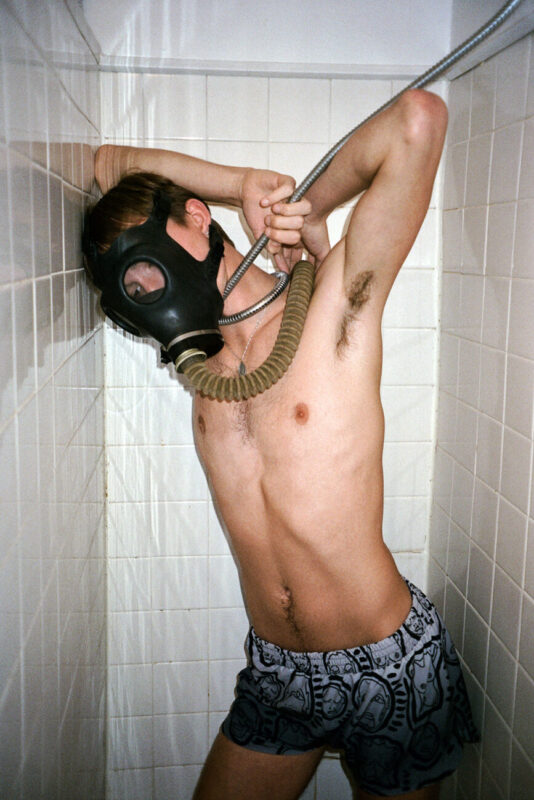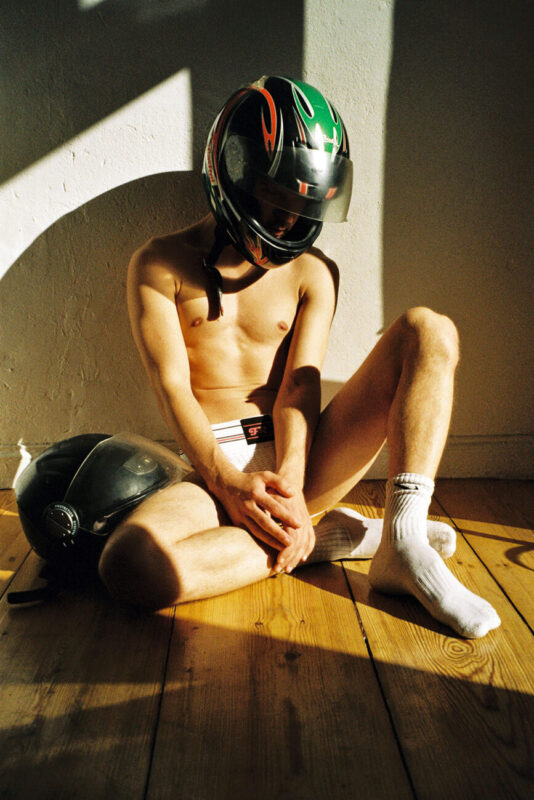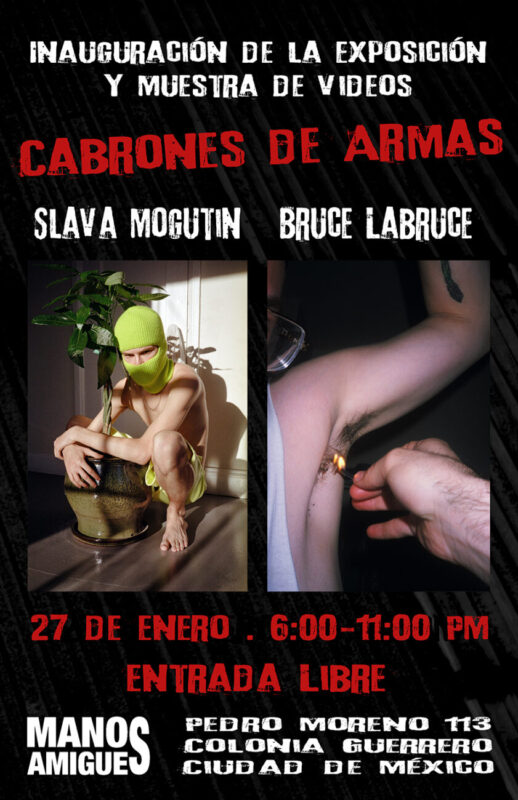Cabrones De Armas, the new exhibition by Bruce LaBruce and Slava Mogutin on view at Manos Amigues in Mexico City from January 27 to February 28, 2023
Riccardo Slavik interviews Bruce LaBruce and Slava Mogutin
“The personal point of view is the crucial part. There are so many photographs and images and movies being produced now for social media and beyond, it’s such an overdetermined field – some might say wasteland – of imagery, that now more than ever you need a really strong point of view and sense of personal style to stand out. Aesthetics do matter.”
Bruce LaBruce
Bruce LaBruce is a filmmaker, photographer, writer, and artist based in Toronto but working internationally. Along with a number of short films, he has written and directed fourteen feature films, including Gerontophilia, which won the Grand Prix at the Festival du Nouveau Cinema in Montreal in 2013. As a photographer he has had numerous gallery shows around the world, including a photo exhibit called Obscenity at La Fresh Gallery in Madrid which caused a national ruckus in Spain. His latest photography books are Photo Ephemera One and Photo Ephemera Two for Baron Books.
Born in Siberia, Slava Mogutin is a Russian-American multimedia artist, author and activist exiled from Russia for his outspoken queer writing and activism. A third-generation writer and self-taught photographer, he became the first Russian to be granted political asylum in the US on the grounds of homophobic persecution. Informed by his bicultural dissident and refugee experience, Mogutin’s work examines the notions of displacement and identity, pride and shame, devotion and disaffection, love and hate. His latest photography book is Analog Human Studies by ManOnPaperArt.
Bruce and Slava have been important independent voices in the queer art scene and good friends for 25 years. This month they are having the first joint exhibition of their photographic works as CABRONES DE ARMAS, on view at Manos Amigues, the first LGBT+ Community Center in Mexico City, from January 27 to February 28, 2023.
We reached out to them for a few questions about the show, their friendship, their photographic work, and queer art in this time and age.



Riccardo Slavik: Apart from being a celebration of your friendship, are there some themes or visual elements that link the works that have been chosen for this exhibition?
Slava Mogutin: This show is a celebration of 25 years of our friendship. In the past Bruce and I did events and performances all over the world. I starred in his movie Skin Flick (1998) and he starred in my music video Moon River (Uncut), but we never had a proper show together. It’s a charity show to benefit our friend’s LGBT+ community center/ soup kitchen, and I think it’s a perfect venue. I’m presenting the works from my upcoming book Analog Human Studies, out in February. My art is a celebration of queer community, and for me as a queer refugee it’s important to be able to give back to the community that inspired and kept me going over the years.
Bruce LaBruce: I sent Slava a large selection of photos to choose from, so he essentially edited the show. I think our photographic work shares a strong current of sexuality and fetish that transcends more orthodox or conventional representations of desire and the body. We both have backgrounds in both fashion and porn, which comes through in the photos. There’s also a certain religiosity to our work. Mine is expressed perhaps through a more literal use of ecclesiastical iconography, exploring the intersection of religious and sexual ecstasy; Slava’s is more subtle, using light and texture to worship the object of desire.
Riccardo: What would you say are the main similarities and differences in your approach to photography?
Bruce: My photographic work tends to be more in the vein of traditional portraiture, often using neutral or coloured backdrops, but adding elements that disrupt the classicism. Six of the photos I’m exhibiting are from a series I did called Obscenity which explored the sexual and fetishistic nature of the lives of saints, all shot in a studio in Madrid with the participation of Spanish pop icons such as Alaska and Rossy de Palma. I also take a lot of photos during the making of my movies; three of the photos displayed in this show were taken on the sets of my movies No Skin Off My Ass, Hustler White, and The Raspberry Reich. Slava’s photos have a more spontaneous and “availabist” quality – he often uses props and locations that are more “off-the-cuff” and improvised, although the final picture somehow looks very composed and aesthetically rigorous. You can feel the creative immediacy in his work, finding inspiration in the moment.
Slava: For me Bruce first and foremost is a brilliant filmmaker and writer. I don’t direct my models, it’s more about collaboration and navigating together a certain fantasy, creating a personal connection that goes far beyond a two-dimensional image. I also like revisiting and referencing my own work and recreating certain scenes and scenarios with different subjects. Both both Bruce and I tend to focus on the queer body and transgressive sexuality as a starting point of conversation about human desire and universal truths that unite us all, despite our religious, ideological and cultural differences.




Riccardo: How important do you think it is right now to be able to express queer content with a personal point of view and how hard is it to find places to do so, especially in the age of social media?
Bruce: The personal point of view is the crucial part. There are so many photographs and images and movies being produced now for social media and beyond, it’s such an overdetermined field – some might say wasteland – of imagery, that now more than ever you need a really strong point of view and sense of personal style to stand out. Aesthetics do matter.
Slava: In the face of increasing corporate censorship across all platforms, it’s more important than ever to resist conformity and mediocrity. I see my art as a weapon against censorship, oppression and bigotry of all kinds. I cannot separate personal from political, just like I cannot separate my art from activism. In my view, social media creates conformity and mediocrity, it’s not about queer community or any other community, it’s about policing, surveillance and data harvesting. I’m being censored on social media in the West way more than I ever was censored in Russia. And Bruce was just permanently banned from Twitter for an image of a trans woman on a cross. I think it says it all, we’re going backwards in terms of our fundamental rights and freedoms.
Riccardo: What is the thing you most admire about each other’s work?
Bruce: Slava is one of the most creative people I know, and I envy his worth ethic and his constant need to produce work. He is also a master of bricolage, possessing a rare talent for making something magic out of nothing. Beyond that, he has a great respect for and rapport with his subjects, so even when he’s asking them to do outlandish or outrageous things, there’s a spirit of collaboration and carnal exploration that never feels exploitations.
Slava: I fell in love with Bruce’s work from the moment I saw his first film No Skin Off My Ass on a bad bootleg VHS copy in Moscow. When I had to flee Russia and moved to New York, Bruce became one of my first and most trusted friends I met in exile. I was very much inspired by his aesthetics, and he was one of the most influential people for me as a young artist. I admire his encyclopedic mind, twisted sense of humor and incredible work ethic. He is a true renegade and contrarian who’s perpetually transgressive without even trying.



